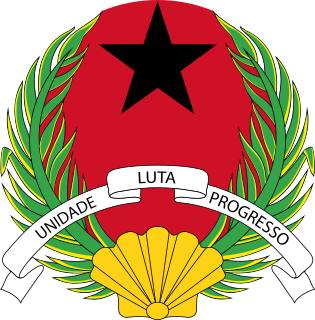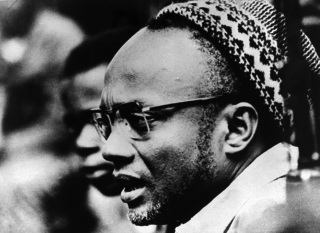
Guinea-Bissau, officially the Republic of Guinea-Bissau, is a country in West Africa that covers 36,125 square kilometres (13,948 sq mi) with an estimated population of 1,726,000. It borders Senegal to the north and Guinea to the south-east.

The economy of Guinea-Bissau comprises a mixture of state-owned and private companies. Guinea-Bissau is among the world's least developed nations and one of the 10 poorest countries in the world, and depends mainly on agriculture and fishing. Cashew crops have increased remarkably in recent years, and the country ranked ninth in cashew production for the year of 2019.

Bissau is the capital city of Guinea-Bissau. In 2015, Bissau had a population of 492,004. Bissau is located on the Geba River estuary, off the Atlantic Ocean, and is Guinea-Bissau's largest city, major port, and its administrative and military centre.

Luís Severino de Almeida Cabral was a Bissau-Guinean politician who was the first President of Guinea-Bissau. He served from 1974 to 1980, when a military coup d'état led by João Bernardo Vieira deposed him. Luís Cabral was a half-brother of Amílcar Cabral, with whom he co-founded the African Party for the Independence of Guinea and Cape Verde (PAIGC) in 1956.

The national emblem of Guinea-Bissau was adopted shortly after independence from Portugal in 1973.
Veríssimo Correia Seabra was a Bissau-Guinean general, known for leading a coup that deposed Kumba Ialá on September 14, 2003.

Amílcar Lopes da Costa Cabral was a Bissau-Guinean and Cape Verdean agricultural engineer, pan-Africanist, intellectual, poet, theoretician, revolutionary, political organizer, nationalist and diplomat. He was one of Africa's foremost anti-colonial leaders.

The Guinea-Bissau War of Independence, or the Bissau-Guinean War of Independence, was an armed independence conflict that took place in Portuguese Guinea between 1963 and 1974. Fought between Portugal and the African Party for the Independence of Guinea and Cape Verde, an armed independence movement backed by Cuba, the Soviet Union, and Yugoslavia, the war is commonly referred to as "Portugal's Vietnam" due to the large numbers of men and amounts of material expended in a long, mostly guerrilla war and the internal political turmoil it created in Portugal. The war ended when Portugal, after the Carnation Revolution of 1974, granted independence to Guinea-Bissau, followed by Cape Verde a year later.

Bolama is the main town of Bolama Island and the capital of the Bolama Region. Though once the capital of Portuguese Guinea, it has a population of just 4,819 and much of its colonial era architecture is in a state of severe decay. The town is almost surrounded by mangrove swamps and is now mostly known for its production of cashew nuts.
Diogo António José Leite Pereira de Melo e Alvim was a former Portuguese colonial Governor of Portuguese Guinea.
Clube de Futebol Os Balantas is a Guinea-Bissauan football club based in Mansôa. They play in the top division in Guinean football, the Campeonato Nacional da Guiné-Bissau. The club is named after the Balanta people, the club location where the people inhabit. Mansoa is the main city of the Balantas in Guinea-Bissau. It is being the most popular club of the Oio Region.

The following outline is provided as an overview of and topical guide to Guinea:
The following is a timeline of the history of the city of Bissau, Guinea-Bissau.

The 1980 Guinea-Bissau coup d'état was the bloodless military coup that took place in Guinea-Bissau on 14 November 1980, led by Prime Minister General João Bernardo Vieira. It led to the deposition of President Luís Cabral, who held the office since 1973, while the country's War of Independence was still ongoing.
The National Broadcasting of Guinea-Bissau, also known only as National Radio, is a public broadcasting company in Guinea-Bissau, whose head office is located in Bissau.

Guinea-Bissau–Turkey relations are the foreign relations between Guinea-Bissau and Turkey. Turkey has an honorary consulate in Bissau and the Turkish ambassador in Dakar, Senegal is also accredited to Guinea-Bissau. It is planned to open in 2022. Guinea Bissau has an embassy in Ankara.